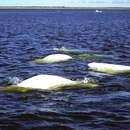en
names in breadcrumbs


In some parts of the Beluga Whale’s range, particularly in Canada and Greenland, intensive hunting represents an ongoing threat to Belugas. In a few instances this is compounded by the less direct and less easily quantified threats of disturbance by vessel traffic (e.g., St. Lawrence estuary, river mouths in eastern Hudson Bay), habitat modification (e.g., large hydroelectric dams in rivers flowing into Hudson Bay and James Bay), contaminants (e.g., St. Lawrence estuary), and possibly incidental catch in fisheries (wherever entangling gear overlaps the animals’ range) (IUCN 2009).
Global climate change may also have serious negative impacts on Beluga Whales. The most serious impacts of climate change on Belugas may not come directly from the effects of weather conditions, but rather indirectly from the role that regional warming and reduced sea ice play in changing human activities. Extensive ice cover and extreme winter conditions (including both darkness and cold) have always limited human activities in the Arctic, and many regions have remained inaccessible to ships and other vessels. As Arctic ice cover declines and the passages between northern landmasses become more navigable, humans will gain easier access to formerly pristine areas that have long served as refuges for Belugas (IUCN 2009).
The number of vessels sailing through the Arctic for gas and oil exploration/extraction, commercial shipping (for both transportation and tourism), and fishing has already increased. Further reductions in sea ice are likely to accelerate this trend in coming decades. With the increase in ship traffic, ship strikes are likely to become an increasingly significant cause of Beluga injury and death. Belugas detect and respond to the presence of icebreaking ships over great distances (up to 50 km). Industrial noise (e.g., from ships, seismic surveys, and offshore drilling), likely disrupts Beluga behaviour and may impair the ability of Belugas to communicate, forage efficiently and generally sense their environment. Noise-producing activities are already ongoing or planned in many areas used by large populations of Belugas, including the Beaufort and Chukchi seas, West Greenland, and Hudson Bay (IUCN 2009).
Pollution may become an increasingly significant problem for Belugas with increasing industrialization and urbanization of the Arctic. Many toxic contaminants become concentrated as they move up the food chain. Because Belugas and other cetaceans are at or near the top of the food chain and have long life spans, they accumulate relatively high concentrations of certain toxins in their blubber and other organs. These may contribute to a range of health problems in the animals themselves and are also of concern to the people who hunt Belugas for food (IUCN 2009).
Loss of sea ice and increased ocean temperatures will affect the distribution, composition, and productivity of prey communities and in turn influence the ability of Belugas to find and catch suitable prey. Given the great uncertainties about how Arctic and sub-Arctic ecosystems function and about how they will be affected by climate change, it is difficult to confidently predict impacts of climate change on Beluga prey populations (IUCN 2009).
As weather patterns become more unpredictable and extreme due to climate change, it is possible that Belugas and other Arctic whales will become more susceptible to ice entrapment. Such events have always occurred and are assumed to contribute to natural mortality in most Beluga populations. However, it is feared that the frequency and scale of the mortality from ice entrapment will increase as the climate changes (IUCN 2009).
As Arctic waters become warmer and patterns of circulation, salinity, and nutrient input change, species that previously were not present in the Arctic will be able to move farther north and remain there for longer. This could have two major types of effects on Belugas. First, species such as Minke and Humpback whales as well as seals and other predators may directly compete with Belugas for food resources. Second, species such as Killer Whales may have more opportunities to prey on Belugas. Both of these factors could negatively affect Beluga populations (IUCN 2009).
One population (or "distinct population segment" in the curious language of the U.S. Endangered Species Act), the Cook Inlet Beluga Whale of Cook Inlet in southeastern Alaska, was listed as endangered by the U.S. National Oceanic and Atmospheric Administration (NOAA) in October of 2008. In December of 2009, NOAA proposed designating more than a third of Cook Inlet as critical habitat for the remaining ~300 Cook Inlet Beluga Whales.